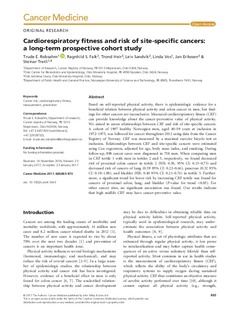| dc.contributor.author | Robsahm, Trude Eid | |
| dc.contributor.author | Falk, Ragnhild Sørum | |
| dc.contributor.author | Heir, Trond | |
| dc.contributor.author | Sandvik, Leiv | |
| dc.contributor.author | Vos, Linda | |
| dc.contributor.author | Erikssen, Jan Emil | |
| dc.contributor.author | Tretli, Steinar | |
| dc.date.accessioned | 2018-06-07T09:38:29Z | |
| dc.date.available | 2018-06-07T09:38:29Z | |
| dc.date.created | 2017-08-03T14:17:14Z | |
| dc.date.issued | 2017 | |
| dc.identifier.citation | Cancer Medicine. 2017, 6 (4), 865-873. | nb_NO |
| dc.identifier.issn | 2045-7634 | |
| dc.identifier.uri | http://hdl.handle.net/11250/2500762 | |
| dc.description.abstract | Based on self-reported physical activity, there is epidemiologic evidence for a beneficial relation between physical activity and colon cancer in men, but find-ings for other cancers are inconclusive. Measured cardiorespiratory fitness (CRF) can provide knowledge about the cancer-preventive value of physical activity. We aimed to assess relationships between CRF and risk of site-specific cancers. A cohort of 1997 healthy Norwegian men, aged 40–59years at inclusion in 1972–1975, was followed for cancer throughout 2012 using data from the Cancer Registry of Norway. CRF was measured by a maximal exercise bicycle test at inclusion. Relationships between CRF and site-specific cancers were estimated using Cox regression, adjusted for age, body mass index, and smoking. During follow-up, 898 cancer cases were diagnosed in 758 men. When comparing men in CRF tertile 1 with men in tertiles 2 and 3, respectively, we found decreased risk of proximal colon cancer in tertile 2 (HR: 0.30, 95% CI: 0.13–0.73) and decreased risk of cancers of lung (0.39 95% CI: 0.22–0.66), pancreas (0.32 95% CI: 0.10–1.00), and bladder (HR: 0.40 95% CI: 0.21–0.74) in tertile 3. Further-more, a significant trend for lower risk by increasing CRF tertile was found for cancers of proximal colon, lung, and bladder (P-value for trend <0.05). For other cancer sites, no significant association was found. Our results indicate that high midlife CRF may have cancer-preventive value. | nb_NO |
| dc.language.iso | eng | nb_NO |
| dc.publisher | John Wiley & Sons, Inc. | nb_NO |
| dc.rights | Navngivelse 4.0 Internasjonal | * |
| dc.rights.uri | http://creativecommons.org/licenses/by/4.0/deed.no | * |
| dc.title | Cardiorespiratory fitness and risk of site-specific cancers: a long-term prospective cohort study | nb_NO |
| dc.type | Journal article | nb_NO |
| dc.type | Peer reviewed | nb_NO |
| dc.description.version | publishedVersion | nb_NO |
| dc.source.pagenumber | 865-873 | nb_NO |
| dc.source.volume | 6 | nb_NO |
| dc.source.journal | Cancer Medicine | nb_NO |
| dc.source.issue | 4 | nb_NO |
| dc.identifier.doi | 10.1002/cam4.1043 | |
| dc.identifier.cristin | 1484025 | |
| dc.description.localcode | © 2017 The Authors. Cancer Medicine published by John Wiley & Sons Ltd. This is an open access article under the terms of the Creative Commons Attribution License, which permits use, distribution and reproduction in any medium, provided the original work is properly cited. | nb_NO |
| cristin.unitcode | 194,65,20,0 | |
| cristin.unitname | Institutt for samfunnsmedisin og sykepleie | |
| cristin.ispublished | true | |
| cristin.fulltext | original | |
| cristin.qualitycode | 1 | |

